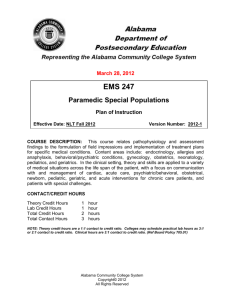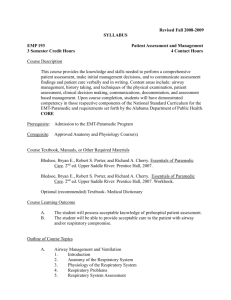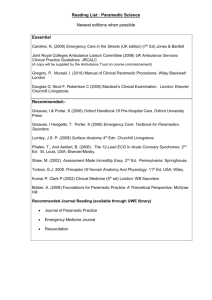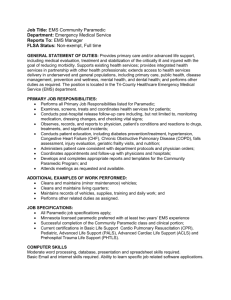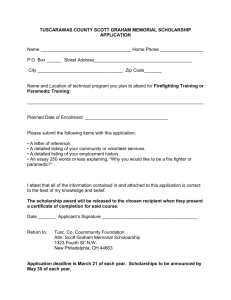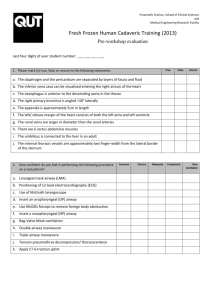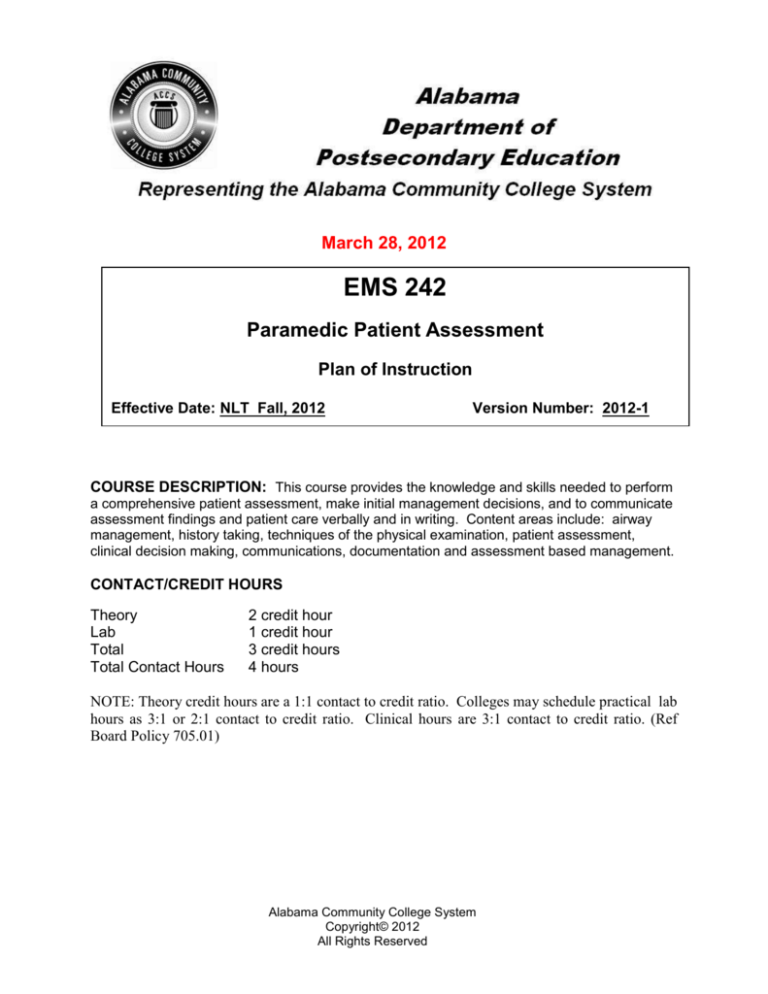
March 28, 2012
EMS 242
Paramedic Patient Assessment
Plan of Instruction
Effective Date: NLT Fall, 2012
Version Number: 2012-1
COURSE DESCRIPTION: This course provides the knowledge and skills needed to perform
a comprehensive patient assessment, make initial management decisions, and to communicate
assessment findings and patient care verbally and in writing. Content areas include: airway
management, history taking, techniques of the physical examination, patient assessment,
clinical decision making, communications, documentation and assessment based management.
CONTACT/CREDIT HOURS
Theory
Lab
Total
Total Contact Hours
2 credit hour
1 credit hour
3 credit hours
4 hours
NOTE: Theory credit hours are a 1:1 contact to credit ratio. Colleges may schedule practical lab
hours as 3:1 or 2:1 contact to credit ratio. Clinical hours are 3:1 contact to credit ratio. (Ref
Board Policy 705.01)
Alabama Community College System
Copyright© 2012
All Rights Reserved
Paramedic Patient Assessment
EMS 242
PREREQUISITE COURSES
As determined by college.
CO-REQUISITE COURSES
As determined by college.
PROFESSIONAL COMPETENCIES
Integrate complex knowledge of anatomy, physiology, and pathophysiology into
the maintenance of a patent airway across the life span.
Integrate complex knowledge of anatomy, physiology, and pathophysiology into
the maintenance of a patent airway across the life span.
INSTRUCTIONAL GOALS
Cognitive – Comprehend principles and concepts related to paramedic patient
assessment.
Psychomotor – Apply principles of paramedic patient assessment.
Affective – Value the importance of adhering to policy and procedures related
paramedic patient assessment.
STUDENT OBJECTIVES
Condition Statement: Unless otherwise indicated, evaluation of student’s attainment
of objectives is based on knowledge gained from this course and previous related
instruction. Specifications for this course are based on the current edition of the
National Emergency Medical Services Education Standards Paramedic Instructional
Guidelines.
ACCS Copyright© 2012
All Rights Reserved
2
Paramedic Patient Assessment
EMS 242
STUDENT LEARNING OUTCOMES
MODULE A – AIRWAY MANAGEMENT, RESPIRATION, AND ARTIFICIAL VENTILATION
PROFESSIONAL COMPETENCIES
A.1 Integrate complex knowledge of
anatomy, physiology, and
pathophysiology into the maintenance
of a patent airway across the life
span.
PERFORMANCE OBJECTIVES
A.1.1Demonstrate methods and devices
used to assure a patent airway in
patients of all ages.
Samples of Behavior:
Assessment
Artificial ventilation
CPAP
PEEP
Various oxygen delivery devices
KSA
3
LEARNING OBJECTIVES
A1.1.1 Identify the anatomy of the airway.
2
A1.1.2 Describe techniques for assessing the airway.
3
A1.1.3 Describe techniques for ensuring a patent airway.
3
A1.1.4 Describe the anatomy, physiology, and Pathophysiology of respiration.
3
A1.1.5 Describe techniques for assessing and managing respiration.
3
A1.1.6 Identify oxygen delivery devices and their associated use.
3
A1.1.7 Explain how to perform a comprehensive ventilation assessment.
3
A1.1.8 Identify ventilation devices and their associated use.
3
A1.1.9 Explain how to assist with patient ventilation.
3
A1.1.10 Value the importance of properly performing patient ventilation.
A
A1.1.11 Describe airway assessment and management across the life span.
3
NOTE: See National Emergency Medical Services Education Standards Paramedic Instructional
Guidelines for associated detailed outline content
MODULE B – PATIENT ASSESSMENT
PROFESSIONAL COMPETENCIES
PERFORMANCE OBJECTIVES
B1.0 Integrate complex knowledge of
B1.1 Demonstrate methods and devices
anatomy, physiology, and
used to perform a comprehensive
pathophysiology into
assessment for patients of all ages.
LEARNING OBJECTIVES
B1.1.1 Discuss considerations for performing a patient assessment across the lifespan to
include:
Scene size up
Primary assessment
History taking
Secondary assessment
Monitoring devices
Reassessment
B1.1.2 Value the importance of an accurate and thorough patient assessment.
NOTE: See National Emergency Medical Services Education Standards Paramedic
Instructional Guidelines for associated detailed outline content.
LEARNING OUTCOMES TABLE OF SPECIFICATIONS
ACCS Copyright© 2012
All Rights Reserved
KSA
3
3
A
3
Paramedic Patient Assessment
EMS 242
The table below identifies the percentage of learning objectives for each module. Instructors
should develop sufficient numbers of test items at the appropriate level of evaluation.
Limited
Knowledge and
Proficiency
Moderate
Knowledge and
Proficiency
Advanced
Knowledge and
Proficiency
Superior
Knowledge and
Proficiency
1
2
3
4
-
10%
-
90%
100%
-
Module A
Module B
Indicator
Key Terms
1
Limited
Knowledge
and
Proficiency
2
Moderate
Knowledge
and
Proficiency
3
Advanced
Knowledge
and
Proficiency
4
Superior
Knowledge
and
Proficiency
A
Affective
Objective
ACCS Copyright© 2012
All Rights Reserved
Learner’s Knowledge, Skills and Abilities
Description
Recognize basic information about the subject including terms and
nomenclature.
Students must demonstrate ability to recall information such as facts,
terminology or rules related to information previously taught.
Performs simple parts of the competency. Student requires close
supervision when performing the competency.
Distinguish relationships between general principles and facts. Adopts
prescribed methodologies and concepts.
Students must demonstrate understanding of multiple facts and
principles and their relationships, and differentiate between elements
of information. Students state ideal sequence for performing task.
Performs most parts of the competency with instructor assistance as
appropriate.
Examines conditions, findings, or other relevant data to select an
appropriate response.
The ability to determine why and when a particular response is
appropriate and predict anticipated outcomes.
Students demonstrate their ability to seek additional information and
incorporate new findings into the conclusion and justify their answers.
Performs all parts of the competency without instructor assistance.
Assessing conditions, findings, data, and relevant theory to formulate
appropriate responses and develop procedures for situation resolution.
Involves higher levels of cognitive reasoning.
Requires students to formulate connections between relevant ideas
and observations.
Students apply judgments to the value of alternatives and select the
most appropriate response.
Can instruct others how to do the competency.
Performs competency quickly and accurately.
Describes learning objectives that emphasize a feeling tone, an
emotion, or a degree of acceptance or rejection.
Objectives vary from simple attention to selected phenomena to
complex but internally consistent qualities of character and conscience.
Expressed as interests, attitudes, appreciations, values, and emotional
sets or biases.
4
Paramedic Patient Assessment
EMS 242
Northeast Alabama Community College
Evaluation of Learning Outcomes for Career/Technical Courses
Student Learning Outcomes Form 1
Faculty regularly review the extent to which the course and program learning outcomes identified in a
course syllabus are being attained by students who complete the course. Each syllabus identifies the
assessment method that will be used to demonstrate student mastery of the desired learning outcomes
for that course. Before teaching a course, faculty should review the syllabus to understand how the
learning outcomes will be evaluated. Once the course is complete, this form is used by the instructor to
report how well students demonstrated mastery of those course learning (and by extension, program
learning) outcomes.
Course Prefix & No.: EMS 242
Instructor:
Semester:
Type of Delivery – Mark One*:
Course Title: Paramedic Patient Assessment
Date:
Section Number(s):
Dual Enrollment
Online
Traditional
*Double click on the appropriate box. When the form field menu appears, select “checked” under Default value.
Note: To insert or delete rows on the table, click on Table on the tool bar.
Learning Outcome
Evaluation Method
Evaluation Results
(Industry or Professional
Competency)
Explain how each learning outcome for this course is
assessed.
Of the students who earned a grade
of C or better for the course, what
percentage demonstrated attainment
of the stated outcomes?
Integrate complex
knowledge of
anatomy, physiology,
and pathophysiology
into the maintenance
of a patent airway
across the life span.
On a designated assignment, the student
will integrate complex knowledge of
anatomy, physiology, and pathophysiology
into the maintenance of a patent airway
across the life span, with at least 75%
proficiency.
Use of Evaluation Results
Explain how evaluation results will be used to improve the course.
*Reviewed:
Division Director or Program Supervisor
Date
*To be completed by Division Director or Program Supervisor Only
ACCS Copyright© 2012
All Rights Reserved
5

